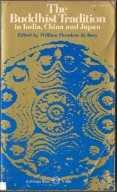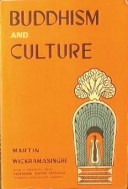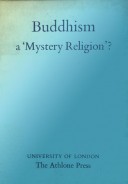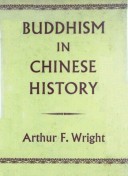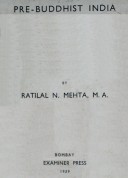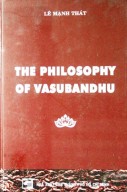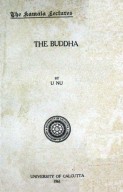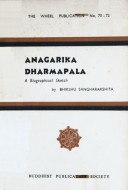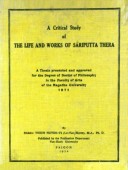Tìm Sách
Sách tiếng Anh-English >> The Buddhist Tradition in India, China, & Japan
Thông tin tra cứu
- Tên sách : The Buddhist Tradition in India, China, & Japan
- Tác giả : W M. Theodore De Bary
- Dịch giả :
- Ngôn ngữ : Anh
- Số trang : 417
- Nhà xuất bản : Vintage books - A division of Random House New york
- Năm xuất bản : 1972
- Phân loại : Sách tiếng Anh-English
- MCB : 12010000002910
- OPAC :
- Tóm tắt :
THE BUDDHIST TRADITION
IN INDIA, CHINA, & JAPAN
Edited by W M. THEODORE DE BARY
With the collaboration of Yoshito Hakeda
And Philip Yampolsky
And with contribution by
A . L. Basham, Leon Hurvitz, and Ryasaku Tsunoda
VINTAGE BOOKS
A DIVISION OF RANDOM HOUSE
NEW YORK
Philosophy and Religion
THE BUDDHIST TRADICTION IN INDIA ,
CHINAAND JAPAN
Edited by William Theodore de Bary
“As an anthology dealing with three major traditions…
This book has no equal.”
David C. Yu,
Journal for Scientific study of Religion
This book, compiled from basic Buddhist writings, present a survey of Buddhist thought in India, China and Japan, covering the central doctrines and practices of a religion that has profoundly influenced human life in Asia. Developments in practical ethics, social attitudes, philosophical speculation, and religious and aesthetic contemplation are all represented by selected excepts from basic writings with succinct introductions and commentary. From these one may observe not only the remarkable vitality of Buddhism in its spread through Asia, but also the essential links between widely diverse forms, showing how the spiritual message of the Buddha found expression in different historical and cultural circumstances. Thus both its continuity in time and its wide range of influence mark Buddhism as a major spiritual force in the world.
Buddha, as the Awakened One, has exemplified to millions of followers throughout the ages a living Truth, a dynamic wisdom and an active compassion.
CONTENTS
PREFACE
EXPLANATORY NOTE
INTRODUCTION
BUDDISM IN INDIA
- EARLY BUDDHISM [ALB]
Historical setting. The Rise of Buddhism – Essential of Theravada Buddhism – The Four Noble Truths – The Nature of Consciousness and the Chain of Causation – False Doctrine about the Soul – The Simile of the Chariot – Change and Identity – The Process of Rebirth – Karma – Right mindfulness – The Last Instructions of the Buddha – The Buddha in Nirvãna – The City of Rightenousness – The Practice of Theravãda Buddhism – The Morals of the Monk – Care of the Body – Meritorious Action – The Virtue of Friendliness – Hatred and Love – Buddhism and Everyday Life. The Social and Political Order – Conditions of the Welfare Societies – Class and Caste in Buddhism – Ashoka: The Buddhist Emperor.
- THE LIFE OF BUDDHA AS A WAY OF SALVATION [YH, WTdb]
Introduction. The Life of the Buddha – His Birth and the Sage’s Prophecies – His Excursions from the Palace – His First Meditation – His Departure from Home and Family – The Failure of Asceticism – Enligtenment – His Compassion on the World.
3. “ THE GREATER VEHICLE” OF MHÀYÀNA BUDDHISM [ALB]. 73
Introduction. The Bodhisatta – The Mahàyàna Ideal is Higher than that of the Theravãda – The Suffering Savior – The Last Son – Joy in All Things – The Good Deeds of the Boddhisattva – The Evils of Meat-Eating – The Gift of Food – The Three Bodies of the Buddha – Emptiness – Faith in Emptiness – Karma and Rebirth – Suchness – All Depends on the Mind – Nirvãna is here and now – Praise of Dharma – Perfect Wisdom Personified – The Blessings of Peace – The Divine Right (and Duty) of Kings – Magical Utterances.
4. TANTRICISM AND THE DECLINE OF BUDDHISM IN INDIA [ALB] .110
Iroduction. Passion as a Means of Salvation – Everything is Buddha.
BUDDHISM IN CHINA
5. THE COMING OF BUDDHISM TO CHINA [WT db,LH]. 125
Introduction. Buddhism and the Chinese Tradition. The Introduction of Buddhihsm, Is Buddhism Un-Chinese? – Why is Buddhism not Mentionned in The Chinese Classics? – Why do Buddhism Monks Do Injury to Their Bodies? – Why Do Monk not Marry? – Death and Rebirth. - Why should a Chinese Allow Himself to Be Influenced by Indian Ways? – Why Must a Monk Renounce Worldly Pleasures?- Why Does Mou Tzu Suppot His Contentions from Secular Rather than Buddhist Literature? – Does Buddhism have no recipe for Immortality?
6. THE SCHOOLS OF CHINESE BUDDHISM I [LH, WTC, YH, WT db]. 139
Introduction. The Three Treatise School – The Twofold Truth . the School of Consciousness Only – Confirmation of the Consciousness Only System . the Lotus School: Tien t’ai Syncretism – All Things Have the Buddha-Nature – The Method of Concentration and Insight in the Mahàyàna – Emptiness, Temporariness and the Mean – One Mind Comprises All Dharmas . the Flower Garland School – Principle and Fact – The Vow to Live the Life of Samanta bhadra – On the Original Nature of Man.
7. SCHOOLS OF CHINESE BUDDHISM I I [LH,PY,WT db]. 197
Pure land Buddhism – Rebirth in the Pure Land – The Orthodoxy of the Pure Land Faith. The Parable of the White Path. The Meditation school – Introduction – The Platform Scripture of the Sixth Patriarch – Seeing into One’s Own Nature – Anecdotes of the Master Ts’ao-shan. Conclusion: The Fate of Buddhism.
BUDDHISM IN JAPAN
8. THE INTRODUCTION OF BUDDHISM TO JAPAN [WT db]. 255
Introduction. The Vision of Prince Shõtoku. Buddhism in the Nara Period (Eighth Century). Buddhism and the State – The Ideal of the Buddhist Layman.
9. SAICHÕ AND THE LOTUS TEACHING [RT]. 277
Itroduction – Vow of the Uninterupted Study of the Lotus Sũtr – Regulations for Student of the Mountain School.
10 KŨKAI AND ESOTERIC BUDDHISM [RT, YH, WT db]. 287
Introduction – Indications to the Three Teachings – Kũkai and His Master – The Transmission of the Law – The Ten Stages of Religious Consciousness – A School of Arts and Sciences.
11 MIDA AND THE PURE LAND [RT, WT db] 314
Introduction. Pioneers of Pure Land Buddhism – The Essentials of Salvation. Hõnen – Invocation of Amida – the One-Page Testament. Shinran and the True Pure Land Sect – Hymn to the True Faith in the Nembutsu – Shinran’s Humble Faith. Rennyo – All Gods and Buddhas are Worshiped in Amida.
12. NICHIREN’S FAITH IN THE LOTUS [ RT, WT db] 345
Introduction – Dedication to the Lotus – Condemnation of Hõnen- Nichiren as Prophet – The Value of Suffering – Nichiren as the Bodhisattva of Superb Action – Japan as the Center of Buddhism’s Regeneration.
13. ZEN [RT, WT db, YH]. 355.
Introduction. Zen Pioneers in Japan – Propagation of Zen for the Protection of the Country – Drink tea and Prolong life – Conversation of Dõgen – Exertion – Realizing the Solution – Sitting and the Koãn – The Importance of Sitting – Body and Mind – Sermon of Musõ Kokushi at the Opening of Tenryũ Monastery – Letter of Takuan to the Shogũn’s Fencing Master – Night thoughts of Takuan – The Autobiography of Hakuin – The Dynamic Practice of Zen. Zen and the Arts.
BIBLIOGRAPHY. 399
INDEX. 403
 Facebook
Facebook
 Google
Google
 Google+
Google+
